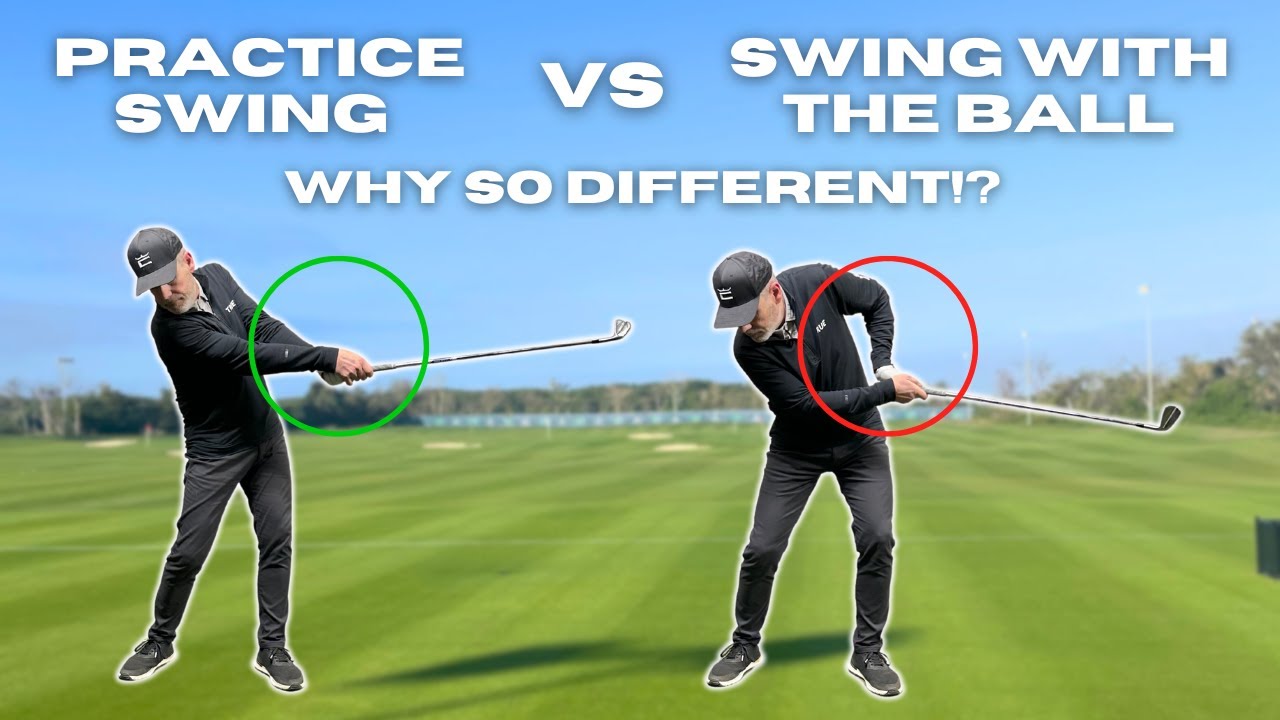WATCH: How to “throw” the club to create more lag and distance
Try this amazing club throwing drill to improve the lag in your downswing, producing more effortless power and yardage.
- LIKE53
- LEGIT4
- WOW3
- LOL2
- IDHT0
- FLOP6
- OB2
- SHANK47
Instruction
Clement: Why your practice swing never sucks

You hear that one all the time; I wish I could put my practice swing on the ball! We explain the huge importance of what to focus on to allow the ball to be perfectly in the way of your practice swing. Enjoy!
- LIKE0
- LEGIT0
- WOW0
- LOL0
- IDHT0
- FLOP0
- OB0
- SHANK2
Equipment
Mitsubishi Diamana WB: Club Junkie takes a technology deep dive

Earlier this week, Mitsubishi announced the return of its iconic Whiteboard profile with the new Diamana WB shaft.
In our launch story, we offered a rundown of the key technology in the new WB — 80-ton Dialead pitch fiber, Aerospace-grade MR70 carbon fiber, Consistent Feel Design, and the Xlink Tech Resin System. To go deeper, however, we enlisted our Resident Club Junkie and bona fide shaft nut, Brian Knudson, to track down someone from Mitsubishi at the PGA Show. Fortunately, Mitsubishi’s Director of Global Aftermarket Sales, Jonathan Alongi, was on hand to answer all of BK’s questions.
Check out their discussion about the new WB, as well as the 20th anniversary of the original design, in the video above — time stamps of key points below, including a definitive answer as to how the surfboard graphic ended up on the original Whiteboard in 2004!
- :40 – Mitsubishi Japan expands to the U.S. in 2004
- :50 – “The shaft that set the standard”
- 1:12 – “The ‘board is back”
- 1:45 – WB or Whiteboard? Or both?
- 1:55 – The first iteration of the sixth generation of Diamana
- 2:10 – Incorporating key technology from a 20-year journey
- 3:10 – Modifying the tip section for more ball speed
- 3:50 – Delivering ball speed in a low-launch, low-spin shaft
- 4:20 – Drilling down on the shaft profile compared to the original Whiteboard
- 5:00 – The most impressive element of the new WB
- 5:30 – Butt, mid, tip specifications
- 6:00 – WB’s iconic graphics and the Diamana legacy — flowers, surfboard, numbering system
- 8:15 – An abundance of available weights and flexes
- 8:55 – More players going lightweight
Check out more photos and see what GolfWRXers are saying about Mitsubishi WB in the forums.
- LIKE1
- LEGIT0
- WOW0
- LOL1
- IDHT1
- FLOP0
- OB0
- SHANK0
Equipment
2024 Vokey SM10 wedges: Club Junkie’s full fitting video

Our Resident Club Junkie, Brian Knudson, goes through a wedge fitting with Chris Baingo, Titleist’s Club Fitting Analyst.
Get the full story on new SM10 wedges in our launch piece.
- LIKE2
- LEGIT0
- WOW0
- LOL0
- IDHT0
- FLOP1
- OB0
- SHANK0
-

 19th Hole1 week ago
19th Hole1 week agoDave Portnoy places monstrous outright bet for the 2024 Masters
-

 19th Hole2 weeks ago
19th Hole2 weeks agoThings got heated at the Houston Open between Tony Finau and Alejandro Tosti. Here’s why
-

 19th Hole1 week ago
19th Hole1 week agoTiger Woods arrives at 2024 Masters equipped with a putter that may surprise you
-

 19th Hole2 weeks ago
19th Hole2 weeks agoReport: Tiger Woods has ‘eliminated sex’ in preparation for the 2024 Masters
-

 19th Hole3 days ago
19th Hole3 days agoTwo star names reportedly blanked Jon Rahm all week at the Masters
-

 19th Hole3 days ago
19th Hole3 days agoNeal Shipley presser ends in awkward fashion after reporter claims Tiger handed him note on 8th fairway
-

 19th Hole2 weeks ago
19th Hole2 weeks agoAddiction, spinal fusion, and scam artists – Everything Anthony Kim revealed in candid interview with David Feherty
-

 19th Hole2 weeks ago
19th Hole2 weeks agoAnthony Kim says doctors told him that he ‘may not have much time left’ ahead of LIV return











Jer
Oct 13, 2017 at 2:55 pm
I shall use this technique when I next find myself in front of the lake to get rid of the clubs that failed me
OB
Oct 12, 2017 at 9:59 pm
Nice try, Shawn, but biomechanically wrong for demonstrating the Kinetic Chain.
Throwing is not whipsnapping the release to whipsnap the clubhead at the distal end of the chain.
The only thing throwing demonstrates is the tangential path of the swing with the club rotating around it’s Center of Mass…. not ‘release’.
MB
Oct 13, 2017 at 2:42 am
Exactly.
Shawn Clement
Oct 13, 2017 at 11:03 am
Yeah!
Andrew Cooper
Oct 13, 2017 at 7:51 am
I think you’re over thinking this and getting to hung up on details. The idea is to tap into a movement that you’d do instinctively and athletically (reacting to a target and a task) and bring that feeling into your golf swing. It’s about reacting, not thinking.
Shawn Clement
Oct 13, 2017 at 11:04 am
Thank you for that Andrew! Nice comment!
Shawn
OB
Oct 13, 2017 at 3:45 pm
But “reacting instinctively” for a “feeling” is chaotic because the brain works on a “best guess” basis.
To make the movement automatic and accurate you must first practice consciously and then over time the brain will “grow into” the golf swing movements. You just can’t skip over conscious practice and hope that your instinctive feelings will give you the desired results. You gotta practice for at least 90 days before your brainlet grows enough neurons in your Motor Cortex to become unconsciously automatic at anything you do at high speed. That’s proven biomechanical science… unless you believe in “golf tips” and the power of your massive intelligence and athleticism…. even then ….
Andrew Cooper
Oct 14, 2017 at 8:07 pm
OB, you should have more faith in your innate abilities. Trying to consciously learn, or teach someone, the kinematics of the golf swing is doomed to failure. From the top of the backswing to impact is a fraction of a second, accelerating the club head from 0 mph to 100+mph speed- the idea that you could consciously sequence all the moving body parts in that motion is crazy. Yes there is a kinetic sequence to it, but you’re talking about tiny fractions of seconds between one body part firing and slowing down, before the next body part fires and slows down and so forth-it’s simply impossible to consciously sequence it. You can study it, but you can’t consciously perform it. It’s got to be a reaction. And that’s where the beauty of the human body comes in-it can actually do a really good job of athletically sequencing itself, as long as it has a clear task in mind and doesn’t get distracted.
OB
Oct 15, 2017 at 1:58 pm
Andy…. it’s obvious you do not understand Motor Control and Learning. I did not say the entire golfswing must be learned in it’s complete movement. A child learn by attempting the whole motion and cannot learn the parts consciously. An adult who attempts to learn like a child by swinging a golf club and learning by trial and error and error and error is futile.
An adult must train each separate movement, like training the legs and hips through conditioning. If your legs are uncoordinated and weak your golf swing will be erratic. Give up and try shuffleboard.
If your core has a bloated belly forget golf. If you suffer from joint arthritis stay away from golf.
If you are a good golfer and you have isolated your problem to one area, train that area without holding and swinging a golf club. Obsessive swinging is a sure path to failure because you must swing consciously and your brain is grooved for failure. If you think your athletic mind can conquer your flaws by mind over matter, you are deluding.
If your problem is in your arms, hands and club, that is an alignment problem that may only need an adjustment, but if it’s within the body you must recondition and retrain your large body muscles because they have a muscle memory IQ of ~4. Read a text book on Motor Control & Learning …. and learn.
Andrew Cooper
Oct 15, 2017 at 6:55 pm
OB, if you know anything of motor skill learning and skill acquisition then you’ll know that attempting to learn or teach through consciously controlling and focusing on training various component body parts (internal focus) is an ineffective method. The science points to an external focus approach (as Shawn Clement advocates) as being more effective.
OB
Oct 16, 2017 at 2:19 am
Please read my comment again because I said adults must first condition their individual body parts consciously and then transition to golf-specific movements. If a body part is deficient then the ‘focused’ golf swing will not overcome that deficiency.
If you believe you can just grab a golf club and somehow imprint, engram, a golf swing I disagree. If you believe a dynamic fault can be fixed with an external focus approach I disagree. If your leg action is uncoordinated because your legs are clumsy no amount of wishful ‘focusing’ will resolve the problem.
The problem Shawn and all other teachers face is golfers expect some patching will solve their swing, and Shawn can’t tell the golfer he/she is not fit for golf because he would lose all his student.
Andrew Cooper
Oct 16, 2017 at 7:15 am
I think you’re overstating the physical conditioning required to play decent golf. Good golfers come in all shapes and sizes. Even among tour players they’re hardly all Olympians. And, yes it’s not a panacea, but an external focus can definitely help improve a dynamic fault. E.g. Someone blading and chunking chip shots-simply focusing on getting a sense of brushing grass with the sole of the wedge can lead to much better physical technique quickly. The brain understands the task, and positions the body to accomplish it. It then uses trial and feedback to get just the right brush feel through the grass.
LenG
Oct 17, 2017 at 2:57 pm
So what you’re saying is external focus is the same as ‘mind over matter’ and you don’t have to be physically fit to get good results? Sounds like another golfing scam to sucker the duffers out of $$$$$$.
Shawn Clement
Oct 13, 2017 at 11:02 am
Dude! Seriously? Maybe 2 students in 1000 would understand what you just said; I deal with normal people that need to understand AT THE MOMENT OF DELIVERY and pay me to be understood!
Shawn
OB
Oct 13, 2017 at 3:38 pm
Point taken, so let me graciously retreat. You are talking to your general audience of golfers and not to golf ‘scientists’, and that’s understandable.
However, what you are trying to demonstrate is the rapid pronation/supination releases of the left/right hands, wrists and forearms in relation to the downswing positions. Your demonstration is okay, but it’s not “practiceable” with golf clubs because the eccentricity of the clubhead creates a feedback torque into the hands. Holding the club at the head is also ineffective.
I suppose you could cut off half the clubhead (preferably a wedge with a 36″ shaft) from the toe section to reduce eccentricity torque and weight, and then practice whipping that while consciously feeling what’s happening to your hands in relation to your body. You can even ‘throw’ it to watch it spin around it’s Center of Mass on it’s tangential trajectory path!
Marty Knowles
Oct 12, 2017 at 12:40 pm
Would have been nice to credit Fred Shoemaker and his Extraordinary Golf system. He’s been teaching this method since the 90’s.
Shawn Clement
Oct 13, 2017 at 10:59 am
Glad you just did Marty!
Terry
Oct 15, 2017 at 1:34 pm
Fred Shoemaker didnt invent it either. Been around much longer than that